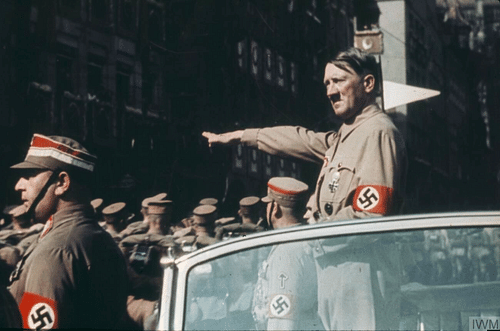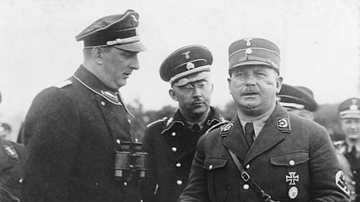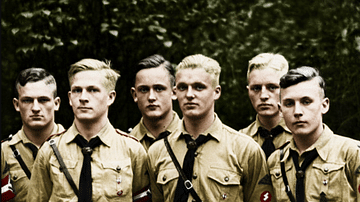
The Reichstag fire of 27 February 1933 was a possible arson attack on the German parliament building. The fire was blamed on a communist anarchist Marinus van der Lubbe (1909-1934), but it may have been the work of the Nazi party's paramilitary group the Sturmabteilung (SA) to discredit the left-wing parties before the forthcoming general election.
The chancellor Adolf Hitler (1889-1945) used the fire as an excuse to declare martial law and issue a decree that gave the police new powers of arrest and imposed significant limitations on people's civil liberties. The decree was shortly followed by the Enabling Act, which allowed Hitler to bypass the parliament and so establish the Nazi totalitarian regime.
The Nazi Party in Power
In the election of November 1932, the Nazi party (NSDAP), although performing less well than in the election of the previous July, had still won enough seats to convince President Paul von Hindenburg (1847-1934) that the best candidate to form a coalition government and be appointed chancellor was Adolf Hitler (1889-1945), the Nazi leader. Hitler's vice chancellor was the conservative politician of the Catholic Centre Party and former chancellor Franz von Papen (1879-1969). The minister of the interior was the Nazi Wilhelm Frick (1877-1946). The minister without portfolio was the Nazi Hermann Göring (1893-1946). Both Papen and Hindenburg were wary of Hitler but thought they could control him better if he was inside the government rather than outside it.
The consequences of the 1932 election resulted, then, in a great step forward for Hitler's plans for total power, but the Nazi party had not won a majority of seats, and so the political situation remained unstable. Hitler had no intention of sharing power and so was not content with the number of non-Nazi ministers in his government. On 1 February, yet another election was called for March 1933. Göring used the police to round up left-wing activists. The Nazi party's paramilitary wing, the SA, conducted a campaign of intimidation towards rival political parties. Something more was needed, though, to guarantee the Nazis would win a majority in parliament. The Reichstag fire produced the perfect propaganda opportunity.
The Fire
The Reichstag parliament building was constructed in the late 19th century. On the night of 27 February, a fire swept through the building, destroying the main chamber and several surrounding rooms. When the building's large cupola collapsed, the draft of air from the hole only fed the fire to rage even more fiercely. Franz von Papen witnessed the fire, which he described as follows:
Suddenly we noticed a red glow through the windows and heard sounds of shouting in the street…from the window we could see the dome of the Reichstag looking as though it were illuminated by searchlights. Every now and again a burst of flame and a swirl of smoke blurred the outline.
(Shirer, 192)
Denis Sefton Delmer, a British journalist, was an eyewitness to the fire as it ripped through the Reichstag and he saw Hitler arrive to personally inspect the damage:
Every minute fresh trains of fire engines were arriving, their bells clanging as they raced through the streets…Across pools of water, charred debris, and through clouds of evil smelling smoke we made our way through rooms and corridors. Someone opened a yellow, varnished door, and for a moment we peeped into the blazing furnace of the debating chamber. It was like opening the door of an oven…[Hitler said] "You are now witnessing the beginning of a great new epoch in German history, Herr Delmer. This fire is the beginning."
(Boyd, 108-9)
Who Started the Reichstag Fire?
The fire was blamed on a Dutch communist anarchist Marinus van der Lubbe. He had, it was alleged, climbed into the building at night and set fire to it. Van der Lubbe was arrested at the scene and confessed to the arson, stating that he had done it as a protest against the Nazi treatment of communists. He also stated that he had acted alone and admitted committing several previous arson attacks across Berlin. This was the version of events issued by the state. As the historian N. Stone notes, "Almost no one believed this then, and many even today cannot accept the Reichstag fire as the result of one man's actions" (60).
It is possible that communist anarchists, who, according to the police, had been planning some sort of action against the state, had decided that van der Lubbe should be caught and take the blame for an act which many historians think must have involved several people. In public, the Communist Party pointed the finger at the Nazis, particularly the thuggish SA, claiming that Nazi arsonists had secretly entered the Reichstag via an underground tunnel from Göring's office in the Ministry of the Interior. There is also debate as to when and how van der Lubbe was detained and whether the fire had already started before he had got to the Reichstag.
A third possibility of the fire's cause is suggested by the historian W. L. Shirer. He suggests that, working independently, both van der Lubbe and the SA had set fires in the Reichstag building on the same night by sheer coincidence. A fourth possibility, the simplest of all, is that the fire was an accident and evidence of an arson attack – the presence of chemicals and gasoline, which was noted in the trial – was merely concocted. It is true that plenty of other old, large buildings with a high proportion of timber and full of combustible materials like heavy curtains have gone up in smoke by accident, such as the fire which destroyed the Vienna Stock Exchange in 1956.

It is important to note that, despite the fire being one of the subjects of investigation in the post-war Nuremberg Trials of remaining top Nazis in 1945-6 and being a topic of intense investigation by historians ever since, there is no firm and undisputed evidence that the fire was not started by van der Lubbe, as he himself claimed. The Nuremberg Trials did bring up some interesting testimony on the subject, notably by Hans Gisevius, at the time an official in the Prussian Ministry of the Interior, who stated on oath that "it was Goebbels who first thought of setting the Reichstag on fire" (Shirer, 193). Joseph Goebbels (1897-1945), Hitler's propaganda minister, committed suicide at the end of the Second World War (1939-45) and so could not respond to the claim. In contrast, the chief of the German General Staff, General Franz Halder, made an even more specific statement, saying that Göring had openly admitted to him responsibility for the fire:
At a luncheon on the birthday of the Fuehrer in 1942, the conversation turned to the topic of the Reichstag building and its artistic value. I heard with my own ears when Goering interrupted the conversation and shouted: "The only one who really knows about the Reichstag is I, because I set it on fire!" With that he slapped his thigh with the flat of his hand.
(Shirer, 193)
Göring, who was also under trial at Nuremberg, denied both in interviews and in the court proceedings that he had made such a statement as Halder claimed. And so the mystery remains unsolved. Whoever actually started the fire was, in any case, soon irrelevant, since Hitler was determined to seize this opportunity to attack his enemies. On first hearing news of the fire, Hitler is said to have exclaimed "That was the Communists. Now we'll strike" (Gellately, 146).

The Trial
The Reichstag Fire Trial was held in Leipzig at the German Supreme Court. The Nazis thought it prudent, given the scale of the destruction, to put on trial not only van der Lubbe but also four people accused of helping him. These so-called accomplices were: Ernst Torgler, the parliamentary leader of the Communist Party, and three Bulgarian Communists, Popov, Tanev, and Georgi Dimitrov (1882-1949, who later served as prime minister of Bulgaria). All four 'accomplices' were found not guilty by the German Supreme Court, much to the annoyance of Hitler, who promptly removed that court's right to try cases of treason in the future. Torgler was, in any case, immediately rearrested and kept in custody as an enemy of the state; he died years later in prison having never been released. Van der Lubbe was found guilty and executed by guillotine.
Consequences: Rule by Decree
As Goebbels noted in his diary the day after the fire, "Now we'll act." (Dülffer, 33). Hitler was certainly keen to exploit the disaster and add to many people's already healthy suspicion of communists by implicating the movement in anarchist acts. Even more, the Nazis now claimed that communists wanted nothing short of a revolution. The Nazi propaganda machine, masterminded by Goebbels, went into overdrive to exploit the act for all it was worth and attack the Nazi party's opponents across the political spectrum.
As chancellor, Hitler pushed through the parliament an emergency decree the day after the fire, the Decree for the Protection of the People and the State (aka the Reichstag Fire Decree). This was effectively a declaration of martial law, which Hitler said was necessary in order to ensure no more anarchist acts followed and that the German people were protected. The decree gave the SA and the other Nazi paramilitary group the SS (Schutzstaffel) a wide range of new policing powers, and it gave the state police increased powers to arrest. Henceforth, treason carried the death penalty. The SA, SS, and state police began to arrest anyone deemed an enemy of the Nazis. Many of those arrested eventually ended up in concentration camps, with no hope of a trial. Also on the 28 of February, the Communist Party was banned. No citizen, regardless of their political leaning, was left untouched by the decree which had far-reaching consequences, as here summarised by the historian J. Dülffer:
It suspended the state of law as a whole and itself remained the 'basic law' of the National Socialist regime until 1945. It suspended the most important basic rights of the Weimar constitution: personal freedom, the free expression of opinion, the freedom to form organizations and to assemble, and the privacy of correspondence. Unreasonable searches, the seizure of and restrictions on property – all became possible.
(33)

In practical terms, the decree meant that citizens could no longer enjoy a free press, speak openly in public without fear of police intervention, or gather in groups to protest. The state could freely search people's homes and intercept and monitor private letters, telegrams, and telephone conversations. Anyone caught 'causing a disturbance' and carrying a weapon could be tried and executed.
The Enabling Act
In the elections of 5 March 1933, the SA performed its usual acts of inhibiting the campaigns of rival parties and intimidating voters at the polling stations. The Nazis gained 44% of the votes in the election, winning 288 seats (of 608 available), 92 more than in the last vote. They still did not have a majority, but this was achieved by joining forces with the conservative-nationalist German National People's Party (DNVP), which had won 52 seats. The DNVP was led by Alfred Hugenberg (1865-1951).
After the fire rendered the Reichstag building unusable, the German parliament met in the Kroll Opera House. The new Nazi-led government wasted no time consolidating its position. After all, the rival left parties had still, despite all the intimidation and anti-revolution Nazi propaganda, gained over 30% of the vote. The Enabling Act (The Law for Removing the Distress of the People and the Reich) was passed on 23 March 1933. The Enabling Act needed two-thirds of the parliament to back it, and this was achieved by banning the Communist deputies from attending and having the SS and SA intimidate those other non-Nazi members who did. The Enabling Act, which was given a four-year time limit (a limit which was never enforced), meant that Hitler could now pass laws without needing to go through the parliament at all. As Shirer notes, the Reichstag parliament "met only a dozen times up to the war, 'enacted' only four laws, held no debates or votes and never heard any speeches except those made by Hitler" (274). Democracy in Germany was officially dead.
At the end of March, a boycott of Jewish businesses was imposed. All rival political parties were banned. Jewish people were banned from the Civil Service. Hitler gained the support of big business interests by promising their property would not be attacked, large rearmament contracts would soon appear, and trade unions would be banned. A ministry of propaganda was created. When Hindenburg died in August 1934, Hitler became the president as well as chancellor of Germany. The army swore an oath of allegiance to Hitler personally. The Nazis now had total power, and it would only be relinquished following Germany's defeat in WWII in 1945. Democracy once again returned to the rebuilt Reichstag. Marinus van der Lubbe was awarded a full pardon by the German state in 2008, but the debate as to who really started the Reichstag fire continues today.







